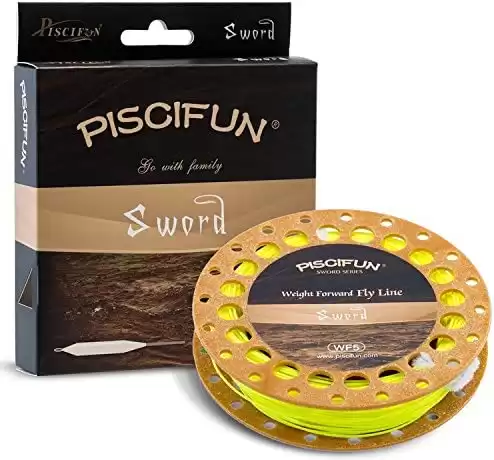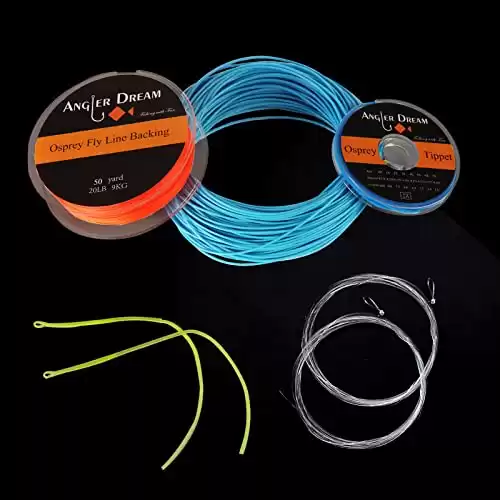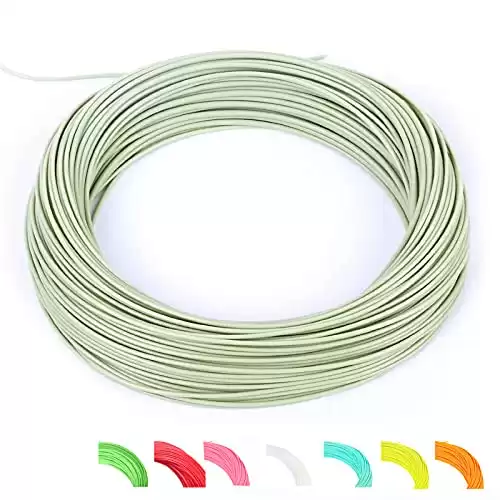Finesse fishing is the 1-weight fly line. A 5-inch trout will feel like a record breaker on a 1-weight fly line. Fly fishing with a low weight like a 1 weight is challenging and a great deal of fun. The presentation from a 1-weight fly line is delicate and graceful.
The casts will be short as the line is much lighter and the rods a great deal whippier.
We cover the best 1-weight fly lines and what to look for when shopping for one.
When to use a 1-weight fly line (or 1 wt)
A 1-weight fly line should be used with a 1-weight fly rod. Some may overline a zero weight with a 1 weight but that’s more common with heavier rods and lines.
A 1-weight fly line is an excellent line for fishing circumstances where short casts and delicate presentations are required.
It’s a top choice when fly fishing small mountain streams for trout where casts are short and often just roll casts or short flick casts.
|
|
|
|
Understanding fly line tapers
Weight Forward Taper (WF)
Weight Forward Tapers are when the front or head section (approximately 35-40 feet) is much thicker than the running section. This additional line weight and diameter makes it easier to load the rod and cast your flies further.
The Weight Forward Taper helps generate energy on the forward and back casts to help you shoot line out, especially during a double haul.
Double Taper (DT)
The Double Taper is when there is a taper similar to the Weight Forward at the front and end of the line. The purpose of this is to create open loops useful when performing roll casts (and especially long ones with spey hybrid rods).
How are Weight Forward and Double Tapers different?
Weight Forward and Double Tapers are similar – they help you generate more energy for longer and effortless casts. Try both of them on the water. It’s up to personal opinion. The Fishing with a Fly office is team Weight Forward but a couple of our fishing buddies are on the Double Taper team.
Level Taper (LT)
A Level Taper fly line is the same diameter throughout the entire fly line. The taper makes long casts harder as it’s more difficult to load the rod. However, the line has a small profile on the water and displaces less when the line is laid down or taken up. If you’re fishing in shallow, clear water it may be a good choice. But in our experience, a weight forward or double taper with a longer-than-normal leader (say 15 feet or more) does just as well and you can cast it further easily.
Shooting Taper (ST)
A Shooting Taper is a length of approximately 30 feet on the front end of the fly line that is heavier than the rest of the fly line. The Shooting Taper helps load the road to make double hauls and shooting lines much easier. This is not common in 1-weight fly lines. And if you’re looking to make longer casts, we’d recommend a heavier fly line such as a 4-weight fly line or 5-weight fly line at least.
Features of the best 1-weight fly fishing lines
Floating, sinking, or sink tip
While this seems straightforward, we’ll briefly explain what each is before sharing what to look for:
- Floating: the line floats on or at the surface of the water
- Sinking: the line sinks below the water
- Sink tip: the first several feet are a heavy line or cord that sinks. Often it attaches to a floating line to make the line more adaptable to fishing situations.
A 1 weight fly line will almost always be a floating line. Most of your fishing will be shallow or at the water’s surface with a dry fly or emerger. Sometimes you can get away with fishing a small streamer such as a wooly bugger with a 1 weight fly line and rod.
If streamer fishing is your strategy, you’d be better served with a heavier rod and line.
Fly line color
Fly line color is highly debated. There are two things to keep in mind: your ability to see the line in the water and the fish being above to see your line.
Most of your fishing with a 1-weight line will be in clear water conditions and shallow. While a bright colored line will be easy for you to see, so will it be for fish.
We recommend a bland color like white, brown, blue, or dark green.
Mendability
Mendability is measured by the line’s flexibility and memory. The more mendable the more flexible and less memory it has. There are pros to both. Heavier line weights often are less mendable because they are thicker lines made for longer casts and casting heavier flies.
Most 1-weight fly lines are mendable as the line is thin and highly flexible. Mendable line makes fishing in streams easier as your line falls where it is instead of remaining looped up.
The best fly-line brands
Scientific Angler
Scientific Anglers is best known for inventing PVC-coated floating fly lines. They continue to innovate in fly line cores and coatings. They are a market leader that demands a higher price with its investments in product research and the sport of fly fishing.
Piscifun
Founded in 2013 by two close friends who have always had a passion for fishing and family. This passion led to the company slogan: “Fish with Family”. As a fishing brand dedicated to offering high-quality, affordable fishing gear, Piscifun strives to cut down circulation costs.
AnglerDream
An excellent affordable fly fishing company that believes quality fly fishing equipment does not have to break the bank. They make fly fishing gear for the hobbyist.
The best 1-weight fly lines on the market
Piscifun Sword
Piscifun Sword is a weight-forward floating fly line that comes in at 90 feet in length. The fly line is reliable and comes with a one-year warranty.
The Sword fly line is slick due to its PVC layer that allows for the line to slide through your rod’s eyelets with the least amount of friction. This allows effortless casts and longer casts than other competitors who do not value creating a slick line.
Features:
- Length: 90 feet
- Material: Nylon+PVC
- Color: Fluorescent Yellow, Orange, Green, Moss Green
- Breaking strength:
Specs:
- Tip: 0.5 feet
- Front taper: 4.2 feet
- Belly: 29.5 feet
- Rear taper: 10 feet
- Running line: 45.6 feet
- Total length: 90 feet
AnglerDream
The AnglerDream fly line is a weight-forward taper fly line. It’s an excellent beginner and expert fly line. At a low price point, it’s affordable at all levels.
It’s adaptable too. Cast dry flies with ease and make them turn over. Then tie on a streamer and deliver it delicately with a double haul.
The nylon coating makes the line zip through your rod’s eyelets with minimal friction.
Features:
- Length: 100 feet
- Material: Nylon+PVC
- Color: Yellow, Orange, Blue, Pink, White, Green
- Breaking strength: 30 pounds
Specs:
- Tip: 0.5 feet
- Front taper: 6.5 feet
- Belly: 20 feet
- Rear taper: 13 feet
- Running line: 60 feet
- Total length: 100 feet
MAXIMUMCATCH Maxcatch
MAXIMUMCATCH creates quality, affordable fly lines. We’ve been pleased with the construction of their fly line. Similar to the Piscifun and AnglerDream, the MAXIMUMCATCH is a weight-forward fly line.
Features:
- Length: 100 feet
- Material: Nylon
- Color: Teal Blue, Elegant Pink, Ivory White, Moss Green, Satin Orange, Fluo Yellow, Pale Green, Fire Red
- Breaking strength: 30 pounds
Specs:
- Tip: 0.5 feet
- Front taper: 3.5 feet
- Belly: 29.5 feet
- Rear taper: 10 feet
- Running line: 56 feet
- Total length: 100 feet
Don’t forget the backing
Fly-line backing is almost a commodity. And especially with a 1-weight fly line and rod, you probably will not go into your backing often. But it’s good to have just in case a true fish of a lifetime makes a run downstream.
A 20-pound fly line backing is plenty strong enough to keep you in the fight and chasing after the fish.
|
|
|
|
Wrapping up: best 1-weight fly line
Fishing with a 1 weight is a blast. The smallest fish feels huge. Hopefully, this helped you make an informed decision about which 1 weight fly line best fits your needs.
With a 1-weight fly line, you want to keep in mind:
- line color
- mendability
- floating, weight forward
Of course, let us know if you have any questions.



